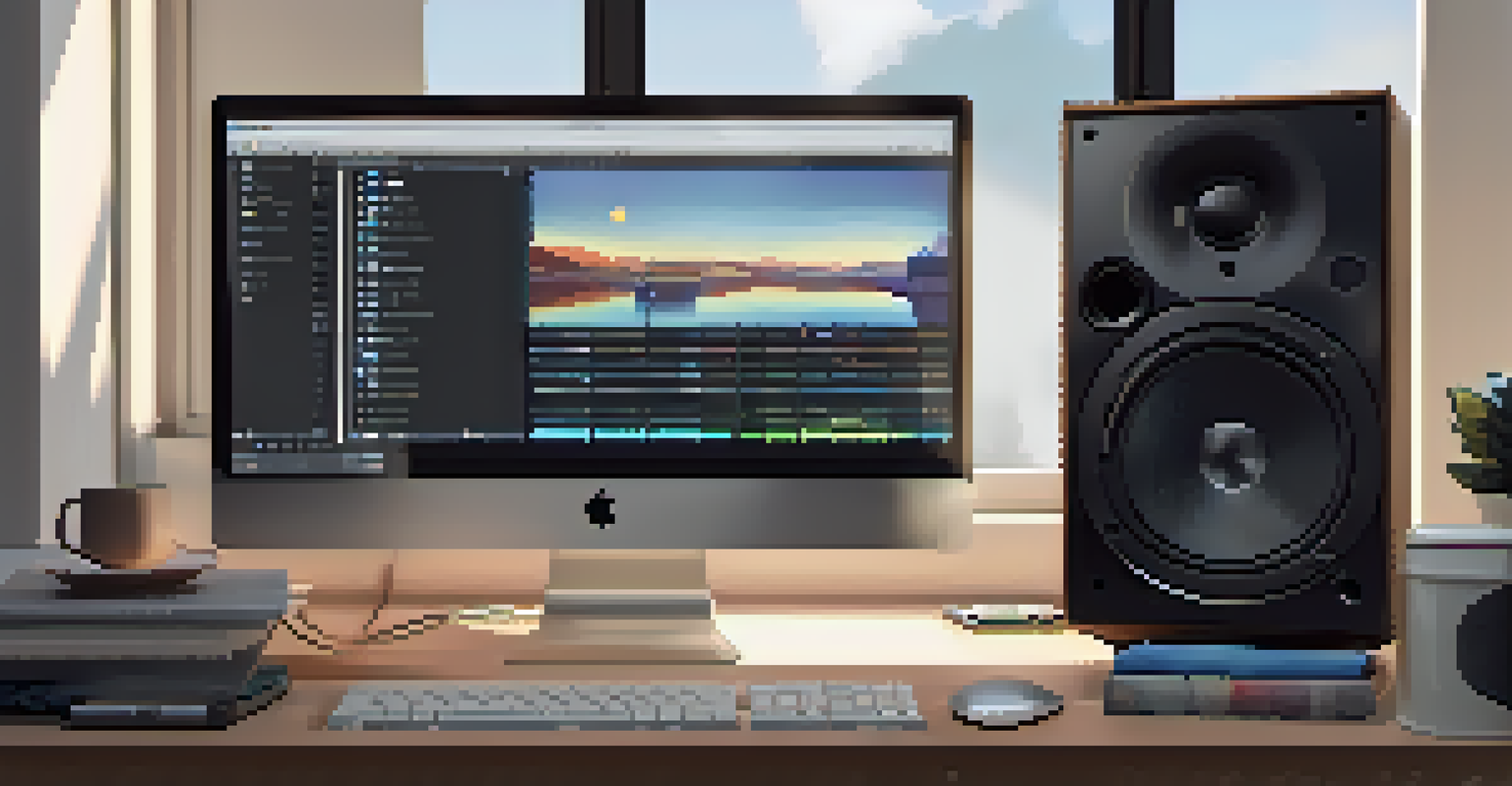Crafting a Music Production Workflow: Maximizing Efficiency

Understanding the Importance of Workflow in Music Production
A well-structured workflow is the backbone of successful music production. It allows you to stay organized and focused, reducing the time spent on repetitive tasks. By understanding your workflow, you can identify bottlenecks and streamline your creative process.
The secret to creativity is knowing how to hide your sources.
Think of your workflow as a roadmap for a journey. Just like a well-planned trip gets you to your destination faster, a good workflow guides your production efforts efficiently. Without it, you might find yourself lost in a sea of files and ideas, which can be frustrating and time-consuming.
Ultimately, a solid workflow enhances your creative output, enabling you to produce high-quality music consistently. It empowers you to spend more time creating and less time troubleshooting, which is essential in today’s fast-paced music landscape.
Setting Up Your Digital Audio Workstation (DAW) Effectively
Your Digital Audio Workstation (DAW) is your primary tool for music production, so it's crucial to set it up properly. Start by customizing your interface for easy navigation; this can include arranging your mixer and plugin windows for quick access. A clutter-free workspace helps keep your mind focused on the music.

Additionally, creating templates for different types of projects can save you a lot of time. For example, if you often produce electronic music, set up a template that includes your favorite synths and effects already loaded. This way, you can dive straight into creativity without wasting time on setup.
Streamline Your Music Workflow
A well-structured workflow enhances creativity and efficiency in music production.
Lastly, familiarize yourself with keyboard shortcuts in your DAW. These shortcuts can significantly speed up your workflow, allowing you to execute commands without breaking your creative flow. The less you have to reach for your mouse, the more you can focus on your music.
Organizing Your Files for Easy Access and Retrieval
File organization is often overlooked but is essential for an efficient music production workflow. Establish a clear folder structure on your computer, categorizing projects by genre, date, or type. This way, you can quickly locate the files you need without sifting through a chaotic mess.
Good design is a lot like clear thinking made visual.
You might also consider using cloud storage solutions for backup and accessibility. Having your projects and samples available from multiple devices ensures that you can work on your music anytime inspiration strikes. Plus, it safeguards your work against unexpected data loss.
Remember to label your files clearly, including version numbers if necessary. This practice not only saves time but also prevents confusion when you have multiple iterations of a project. Organization is key to maintaining momentum in your music production process.
Utilizing MIDI and Audio Templates for Quick Starts
MIDI and audio templates can be game-changers for your workflow, allowing you to jump right into the creative process. By creating templates with pre-set instruments and effects, you eliminate the need to start from scratch every time. This can be particularly useful when working on a series of tracks that share a similar vibe.
Consider setting up a few versatile templates for different styles you produce, whether it’s hip-hop, pop, or ambient. Each template should include the core elements you typically use, like drum patterns or synth sounds. This way, you can easily adapt them to fit new ideas without losing precious creative time.
Set Up Your DAW for Success
Customizing your Digital Audio Workstation and using templates can save valuable time and maintain focus.
Moreover, don’t hesitate to experiment with your templates. As your skills and preferences evolve, so should your templates. Regularly updating them keeps your workflow fresh and inspiring.
Incorporating Effective Collaboration Tools into Your Workflow
Collaboration is a vital part of music production, and using the right tools can enhance your workflow significantly. Platforms like Splice or Soundtrap allow you to share projects and collaborate in real-time, making it easier to work with other musicians or producers, no matter the distance.
Consider integrating communication tools like Slack or Discord for seamless discussions with collaborators. These platforms facilitate quick feedback and brainstorming sessions, which can be invaluable for keeping the creative momentum going. The more streamlined your communication, the smoother your collaborative process.
Lastly, always keep your collaborators' preferences in mind. Understanding their workflow can help you tailor your approach, making it easier to blend your sounds effectively. A harmonious collaboration can lead to innovative music that reflects the strengths of everyone involved.
Implementing an Efficient Mixing and Mastering Process
Mixing and mastering can often feel overwhelming, but having an efficient process in place can make all the difference. Start by establishing a mixing template that includes your go-to effects and settings. This way, you can streamline your workflow and focus on the artistic aspects of mixing rather than getting bogged down in technical details.
Also, consider breaking your mixing sessions into smaller, manageable tasks. Instead of trying to tackle everything at once, focus on one element at a time, like the drums or vocals. This method not only keeps you organized but also allows you to give each part the attention it deserves.
Regularly Review Your Process
Reflecting on your workflow and seeking feedback can lead to continuous improvement and greater productivity.
Finally, don’t rush the mastering process. Take your time to ensure that your track sounds polished and cohesive. A good master can elevate your music, making it ready for distribution, so treat it as the final touch of your production workflow.
Reviewing and Reflecting on Your Workflow Regularly
To truly maximize your efficiency, it's important to review and reflect on your workflow regularly. Take note of what works well and what could be improved. This reflection helps you to identify patterns in your productivity and allows you to make informed adjustments.
Consider keeping a journal or a digital log of your production sessions. Documenting your experiences can reveal insights that help you refine your process over time. This practice encourages self-awareness and continuous growth as a music producer.

Lastly, don’t hesitate to seek feedback from peers. Sometimes, an outside perspective can offer valuable suggestions for enhancing your workflow. Embracing change and being open to new ideas can dramatically improve your efficiency and creativity.